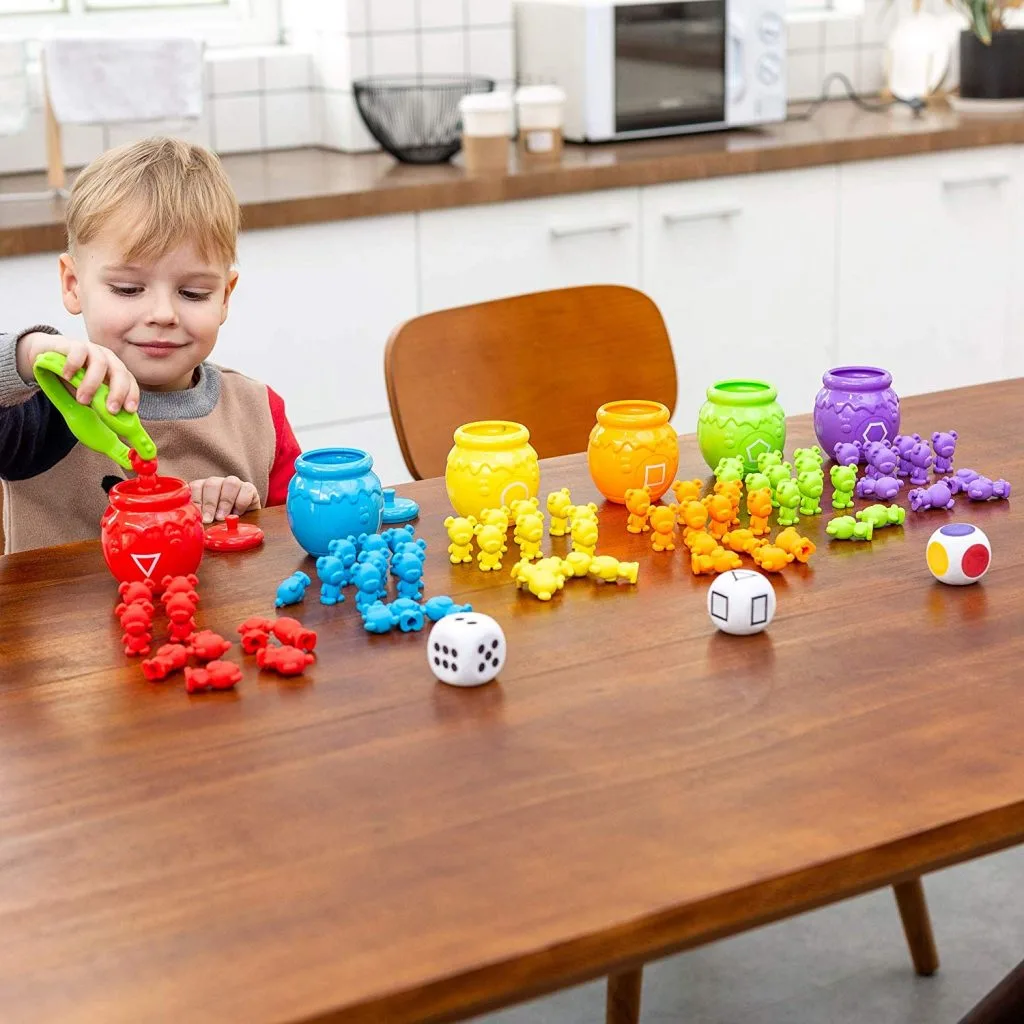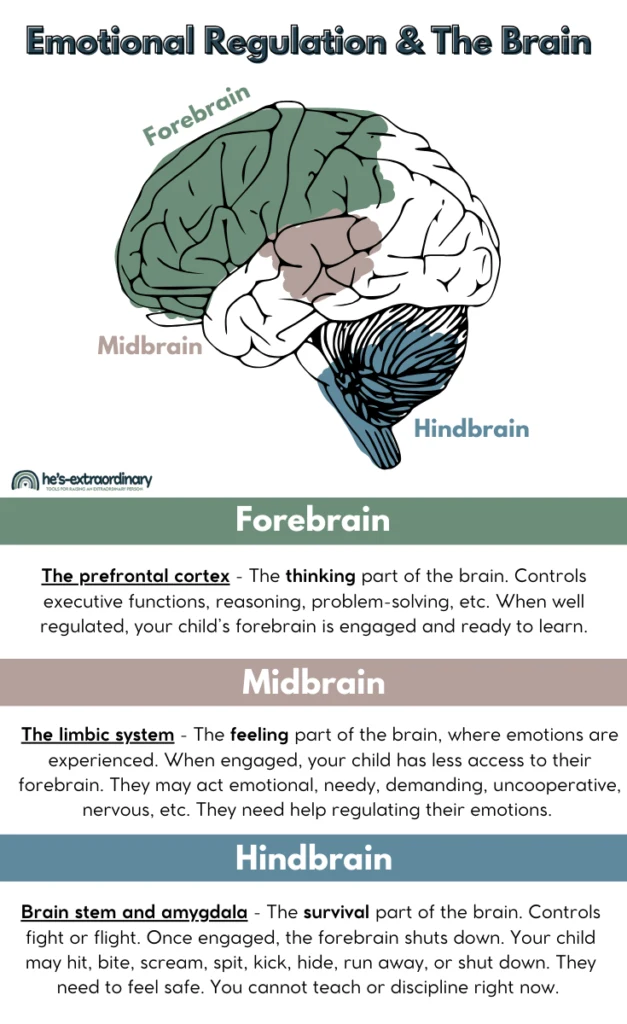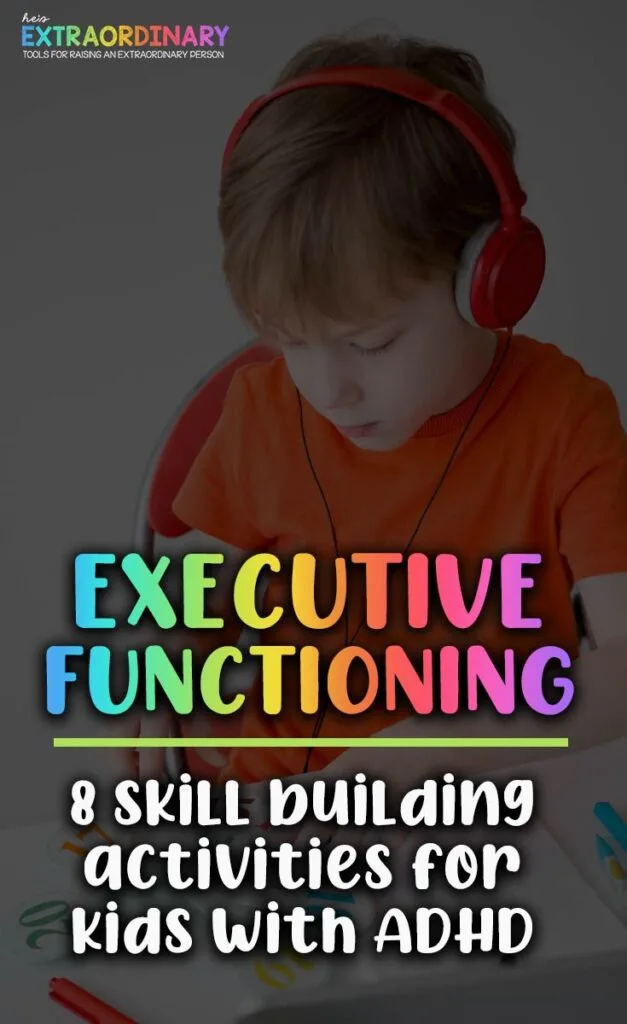What’s inside this article: An overview of executive functions and how ADHD and autism often cause children to have lagging skills, a look at how executive dysfunction impacts them, and some general tips/activities to help improve executive functioning.
Disclaimer: This post contains affiliate links.

Executive functioning issues are a hallmark symptom of both ADHD and autism.
Children with executive functioning problems are more likely to act impulsively, have strong emotional reactions and outbursts, be rigid, disorganized, and unable to plan or complete a task with multiple steps.
When executive functions are well developed, a child will be able to:
- regulate their emotions
- consider consequences
- think before acting
- understand how other people feel.
List of Executive Function Skills:
Click on any of the links below to learn about that specific executive functioning skill.
Executive functions are the more complex functions of the brain. These take place in the brain’s prefrontal cortex. This includes :
- Working memory
- Decision making
- Planning
- Self-understanding
- Self-restraint (impulse control)
- Empathy
- Morality
- Emotional regulation
- Problem-Solving
- Organization
- Perspective-taking
- Cognitive Flexibility
These are all abilities and qualities we want and hope to raise our children to have.
But there are some things you should know first.
Setting Parental Expectations
Parents should be aware of their child’s executive functioning skills, as well as what typical age-level abilities are, to ensure they’re setting appropriate expectations.
Brain Development
The amygdala is the part of the brain that is responsible for basic human instincts, including strong emotional reactions and impulses – this includes our fight or flight instinct and primitive reflexes. It is well-developed from birth. It’s part of the hindbrain, which is pink in the diagram below.
But, even in a typically developing child, the prefrontal region of the brain (forebrain), which is responsible for executive functions, is not fully developed until its mid-twenties.
As parents, it’s really important to understand this.
This means that all the behaviors we want and expect our kids to demonstrate depend on a part of the brain that isn’t fully developed yet.
This part of the brain simply isn’t capable of fully functioning all the time and is the reason why kids are prone to acting without thinking.
It’s unrealistic for parents to expect children always to be rational, regulate their emotions, and
Of course, many children are able to show these abilities some of the time, but children simply aren’t developmentally able to use their executive functions all the time. Plus, research shows that executive functions in children with ADHD and/or autism are, on average, about 30% behind their peers.
This may have even been noted in their psychoeducational
Realistic Expectations
Adjusting your current expectations or knowingly setting realistic expectations for your child can help you see that your child is doing the best that they can with the brain that they have.
As a parent, you can acknowledge this and help your child develop appropriate behavior.
When your expectations are reasonable, you will see more opportunities for your child to succeed.
It’s easier to stay calm and patient when your child is having difficulty – because you know it’s past their current abilities but will get there in time.
Executive Functions: Temper Tantrums VS Meltdowns
There are actually significant differences, neurologically, between a temper tantrum and a meltdown – those differences come down to which parts of the brain are in control during either a meltdown on a temper tantrum.
Tantrums
As awful as tantrums can be, it is actually an indicator that your child’s executive functions are developing typically. So, in a strange way, you can actually be proud of your kiddo for that fit they’re throwing.
A child having a tantrum is acting out to get their way, or push your buttons, or get some attention. They’re likely operating with the forebrain and midbrain – the thinking and feeling brain.
They may appear out of control but can stop the tantrum abruptly (for example, when they get what they want) and return to making logical decisions and behaving calmly.
Parents are taught to ignore tantrums – because if their child’s tantrum doesn’t get them what they want or get a reaction out of them, they will learn that this strategy is ineffective and, over time, will stop.
Young children use tantrums because they don’t have the communication skills yet to communicate their wants and needs. Learning about their feelings and positive ways to communicate will drastically reduce the frequency of tantrums.
Meltdowns
A meltdown is completely different.
When a child has a meltdown, thanks to their amygdala causing fight or flight to kick in, the prefrontal cortex, responsible for executive functioning, completely shuts down.
Stress hormones flood their tiny body, and temporarily, they are literally incapable of controlling their actions and emotions or using any executive functions like considering consequences, problem-solving, or listening to reason.
When your child is having a meltdown, they do not need you to set firm boundaries or ignore their outbursts. Your child needs you to be nurturing and comforting until the meltdown is over.
The best approach to take will vary depending on your child’s temperament and what the trigger of the meltdown was. Just remember that this is an emotional reaction and not a behavior choice.
Handling Meltdowns
When your child is having a meltdown, trying to talk to them about consequences or appropriate vs inappropriate behavior will not help and may, in fact, make things worse.
The executive functions of the brain need to be up and running for any of this information to be processed.
You can look over this list of de-escalation strategies for meltdowns if you’re not sure what to do when this happens with your child.
When their emotions are regulated again and they are no longer rushing with emotions, you can talk about appropriate vs. inappropriate behavior with them.
It’s better to talk to your child using compassion and understanding than to be punitive. The best strategy for meltdowns is to be proactive.
You can read more about the brain’s development and executive function in detail in the book The Whole-Brain Child: 12 Revolutionary Strategies to Nurture Your Child’s Developing Mind.
This book is an excellent read to help understand your child’s mind and is probably the best parenting book I ever read.
Strategies That Help Improve Executive Functioning Skills
When we practice using our executive functions, it helps them to develop and get stronger over time. Executive functioning is essential for social and emotional intelligence.
As a parent, you can encourage your child to use these skills every day to promote strong executive functioning skills.
1. Decision Making
Give your child choices throughout the day. For little ones, this can be as simple as “Do you want to wear your pink or yellow shirt today?”
Older children should have the chance to make more complex decisions. As parents, it can be instinctual to make the “right” choice for our kids because we don’t want them to make mistakes, but this is a learning experience for children and necessary for them to have strong decision-making skills down the road.
The natural consequences of your choices can be the best learning experience.
2. Practice Problem Solving
If this is an area your child struggles with, try the problem-solving wheel to help teach effective problem-solving skills. Give them hypothetical scenarios and ask them to choose the best option(s) for solving the problem.
Practicing frequently will help them to be able to apply these skills in real-life situations. You can even act out different scenarios and use
Read more about building problem-solving skills here.

3. Play Physical Activities That Require Attention
Kids need to pay attention to instructions and use their impulse control to play certain games. These games are also great ways to provide kids with proprioceptive input and are great for motor planning.
- Freeze dance
- Musical chairs
- Simon Says
- Duck Duck Goose
- Mother May I?
- Red Light, Green Light
4. Play Sorting Games
Getting children to sort objects by changing rules, such as first sorting by color, then mixing them back up, and asking them to re-sort by shape, helps improve cognitive flexibility.
Cognitive flexibility is the ability to adjust your thinking from an old situation to a new situation.
Check out this sorting bears toy set.

5. Play With Building Materials
Children learn best through play and through doing.
Give your child the opportunity to play with building toys, including blocks, mag snaps, train tracks, race tracks, lego, marble runs, etc.
It might seem like they’re just playing, but it takes strategic planning to build things with these toys. Planning, organization, and decision-making go into every creation.
If your child is building a train track, they’ll need a strategy to connect the tracks together at the end.
Likewise, if they’re building a tower from blocks, they’ll learn that you need bigger blocks at the tower’s base, or else it will fall over.
This building can evolve over time. As your child gets older, they can focus on building more complex Lego sets or model airplanes, robots, etc.
These tasks require working memory, the ability to follow multi-step directions, focus, and concentration.
6. Play Board Games That Require Strategy
Strategic board games give your child a chance to practice making a plan and keeping it in mind for several moves. They must also adjust their strategy in response to the other players’ moves.
Through strategizing, a child’s inhibitory control, flexibility, and working memory must work together, practicing many executive functions together.
Some great beginner games include:
Older children can play games that require intermediate skills, like:
7. Improve Empathy
It’s a myth that children with autism lack empathy.
They are very empathetic; the problem is that they often have trouble reading how other people feel and showing their empathy. They don’t pick up on body language and slight changes in tone of voice or facial expression as easily as others.
You can help improve your child’s ability to recognize others’ feelings by drawing their attention to them regularly.
For example, when you’re watching their favorite TV show together, ask your child how they think the character feels.
Do the same while you’re reading together or while you’re out and hear a baby crying – ask your child why they think the baby is crying.
Over time, this will help your child form connections between actions and feelings and help grow their understanding, and they will become more empathetic.
This will also help your child to identify their own big emotions better, and improve their perspective-taking abilities.
Social-emotional learning programs, such as the Zones of Regulation can also help your child build emotional intelligence, which improves empathy.
8. Give Executive Functioning Time to Develop
Finally, you just have to give your little ones some time. As I mentioned earlier, the part of the brain responsible for executive functions doesn’t completely mature until the mid-twenties.
A child with ADHD usually is delayed by about 3 years in their level of executive functioning. I have to remind myself this as my 6-year-old has similar outbursts to my 3-year-old and remember he is doing his best.
As a parent, just keep facilitating opportunities to learn, being patient and nurturing during meltdowns, setting boundaries when you need to, and playing lots of games together.




The Best Gift Ideas for Autistic Children - Raising an Extraordinary Person
Sunday 10th of November 2019
[…] The first time I saw these, my son was using them in his second grade class. All the kids and the teachers love them. They’re a great way to develop visual discrimination, critical thinking skills, problem-solving and other executive functions. […]
Kids Anger Management · Raising An Extraordinary Person
Tuesday 8th of October 2019
[…] Both problem-solving and cognitive flexibility are executive functions. […]
How to Make a Visual Schedule for Your Home - Why Kids Need Structured Routine
Tuesday 24th of September 2019
[…] with the development of some executive functioning skills, such as time management and […]
10 Sensory Activities for Infants (0 - 12 Months) - Baby Sensory Development
Tuesday 10th of September 2019
[…] During baby’s first year, their brain is forming trillions of neural pathways. These neural pathways are what ultimately shape behavior, memories, emotions, intelligence, and later, executive functions. […]
Interoception: What It Is, How It Works, & How to Improve Interoception
Saturday 31st of August 2019
[…] addition to emotions and self-regulation, interoception affects other executive functions, […]